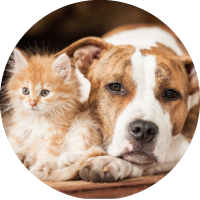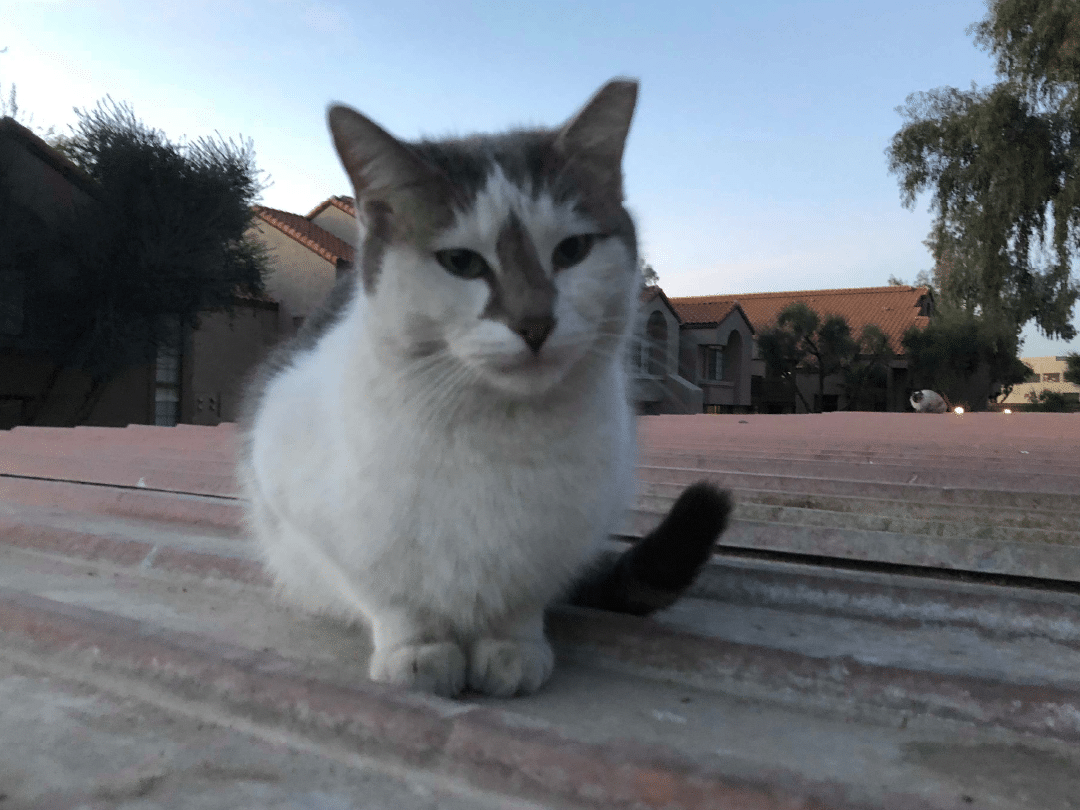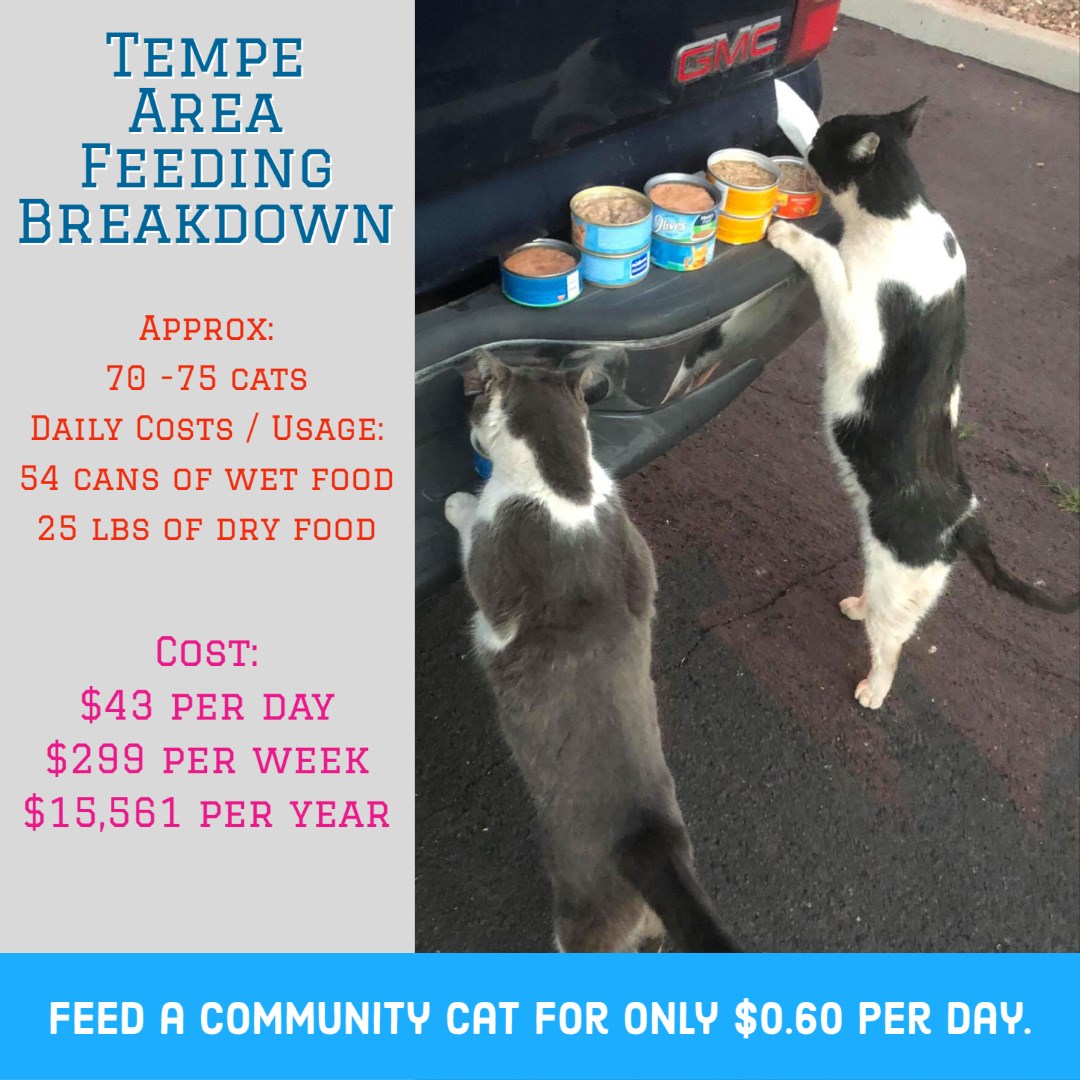
I have had the honor and delight to be the director of Saving One Life for just shy of six years.
When I signed up for this crazy ride, I didn’t think it would have been this fulfilling, enjoyable and exhausting. But, it is all worth it knowing that animals live and find great homes because of the rescue and the efforts of our incredible volunteers.
A few weeks ago, my husband suggested that we start colony feeding one night a week for one of our committed feral community feeders, Anna. The rescue is a big part of our life as a couple and family, and we are fortunate we can run it from our home. I run the day to day operations from my office (AKA, my living room). I liked the idea of getting out and helping in such a direct way.
Community Cat Colony Care is Essential
There’s a side of cat rescue that many people may not know about that certainly isn’t glamorous, but it is essential. Colony Care is at the root of reducing the overpopulation of cats as well as the euthanasia rate. Colony Care is broken down into two main areas:
TNR is the process of trapping, neutering, and returning presumed feral cats to their community (colony). TNR prevents the birth of thousands of unwanted kittens each year!
Colony feeding provides food to feral and abandoned / stray cats that would otherwise starve. We also keep our eye out for sick or injured kitties as well as kittens and provide veterinary care when needed. When possible, adoptable cats are placed in foster homes while searching for an owner who may have lost them.
My Eye-Opening Colony Feeding Ride-Along
Last night, after having to reschedule twice, I accompanied Anna on her nightly colony feeding routine. Truthfully, I didn’t want to go. I have channeled my inner-home body since COVID19, but it was time. I knew the time would fly by because there was a lot to learn, and Anna is a lot of fun to be around. I had my notebook and pen in hand to write down everything I need to know….where to park, how much food at which location, what time of evening was best, would I get hassled by anyone, etc. As the night went on, my somewhat neat handwriting turned into chicken scratch as I tried to note everything down. Anna dutifully kept trudging along from spot to spot.
As we went from location to location, Anna introduced me to the cats pointing out who was semi-friendly, who was new to the colony, and which kitties probably needed to be fixed as they were new arrivals. She stops to pet the few friendlies and points out the difference in placement. She reminds me which recently adopted cat came from what colony (after a thorough search for an owner) and the medical ones the rescue helped. Then, we get back in the car and move to the next location. We do that 14 times more until we have completed all of the feedings.
Colony Feeding is Exhausting, Rewarding Work
THREE HOURS LATER. I was exhausted, and I watched more than anything. Anna repeats this feeding process every night – 365 days a year! She kindly ensures that these lost and abandoned kitties are fed every day. They aren’t HER cats. But she has generously, selflessly stepped up and made them her responsibility.
Not only does she give up 3 hours each night (FYI; that’s 45 days out of a year), Anna often buys food out of her pocket not only for her colonies but other colony feeders and low-income families. By the time Anna is done, all hungry mouths are fed, and she returns home to feed her own cats, finally eat some dinner and crash out because that’s right, she has work in the morning so she can afford to drive around and feed other people’s cats. Keep in mind some of these colonies are several miles from her home, but it isn’t easy to find someone to step up and say, “Sure, I will feed this colony EVERY night. Again, this is a commitment Anna has made for 15 different locations.
The Dedication of Our Volunteers is Astounding
Anna is amazing. She does more than just feed colonies. Anna also actively TNRs, not only at her colonies (which is a part of colony care) but other colonies or areas in need of help. She coordinates food donations and fosters kitties that people rarely want to foster (hospice fostering).
There are many devoted and dedicated people in rescue but few are as completely selfless as Anna. The “Annas” in rescue are a rare and treasured few and they share a similar story — a similar burden– because they said yes to serving the rescue community when others wouldn’t commit.
I know that not everyone that reads this can help feed but I do hope some people do because we need more feeders so that we provide nourishment to more kitties.
I can’t imagine how hard it is to be Anna. As I said, I love the rescue, and I love running Saving One Life, but I do most things from my house, my storage unit, my garage, etc.
We Need Volunteers to Help with Colony Feeding
Please consider getting involved. There are so many ways you can help.
- You can agree to feed a colony nightly or all colonies once a week or once a month.
- You can be a substitute so our regular feeders can take a well-deserved break from time to time.
- Heck, you can even buy some food.
Can you volunteer to take some of that responsibility and help the “Anna’s” in your community?
Can’t volunteer? Share Anna’s story using the social media links to the left or consider purchasing supplies on Saving One Life AZ TNR / Colony Wishlist on Amazon.
Adopt, Don't Shop
Please adopt, don’t shop! You can find a list of our adoptable cats and kittens below
Apply today to become a Volunteer!
something important





